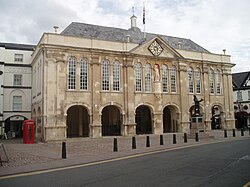Shire Hall (Monmouth)
| Shire Hall | |
|---|---|
 Shire Hall, Monmouth |
|
| Data | |
| place | Monmouth (Wales) |
| builder | Philip Fisher, Bristol |
| Construction year | 1724, baroque |
| Coordinates | 51 ° 48 '43.1 " N , 2 ° 42' 55.5" W |
The Shire Hall in downtown Monmouth , Wales , is one of the UK office of monuments as Grade-I is located -Bauwerk urban striking building in the Baroque style. It was built in 1724 and served as a gathering place for jury courts and quarter sessions of the historic Monmouthshire area . In 1839/40 the trial of the Chartist leader John Frost and others took place here because of their participation in the Newport Rising, an armed workers rebellion, were charged with high treason. The open ground floor of the courthouse was used as a marketplace. Shire Hall is owned by Monmouthshire County Council and offers audiovisual tours of Courtroom 1. Today the building is used as the tourist center and office of Monmouth Town Council and is partially open to the public.
history
The current building was built in 1724 and is at least the fourth building at this point. In the same place there was previously an Elizabethan courthouse built in 1536 , which was partially replaced by a half-timbered building in 1571. Beams from the original building were used in the construction of Shire Hall. There are rooms above the ground floor with stone arcades and an open trading area. The building, described in the Pevsner Architectural Guides series of Buildings of Wales as "a mighty affair", is made of Bath Stone from southern England and was designed by the little-known architect Philip Fisher († 1776) from Bristol designed and cost £ 1700s. In 1725 the jury was moved to the building. The courtroom itself was on the first floor above the open arches with the market area. The clock in the gable was made by Richard Watkins in 1765.
The interior of the building was redesigned in 1828 and the exterior was expanded to include a stair tower with a glazed roof lantern and an impressive staircase. Architect Thomas Hopper was involved in improvements to Shire Hall with Royal Assent . He also worked for many years in the expansion of Penrhyn Castle near Bangor. He and Edward Haydock expanded Shire Hall towards Agincourt Street , creating space for the new staircase and larger courtrooms. Hopper lived on Monnoe Street in Monmouth during this time.
Statue of King Henry V
The statue of Henry V of England (* 1387 in Monmouth), in a niche above the main entrance and under the clock, is generally considered to be of poor quality. It was called "incongruous" ( not fitting the style of the environment ), "rather deplorable", ( rather pathetic) and "pathetic..like a hypochondriac inspecting his thermometer". ( pathetic ... like a hypochondriac who checks his thermometer ). The sculpture was added in 1792 by Charles Peart , a sculptor who was born in nearby English Newton. The inscription reads HENRY V, BORN AT MONMOUTH, AUG 9TH 1387. ( Henry V, born in Monmouth, 9 Aug 1387 ). The date of birth carved in stone is now considered wrong.
Process of the Chartists
Monmouth prison was not far from the courtrooms. The Chartist leader Henry Vincent , who had fought for the right of all men to vote in parliamentary elections, was imprisoned here before he was tried by jury. Vincent was found guilty, but the unpopular conviction led to protests in which miners were killed in a meeting with the military on November 4, 1839 in Newport, later known as Newport Rising .
John Frost was arrested shortly after the uprising, along with other leaders of the group. On December 10, 1839, a special court opened the case in Shire Hall and an appointed grand jury (large jury) deliberated which charges could be brought forward. The grand jury included Lord Granville Somerset , brother of the Duke of Beaufort , John Etherington Welch Rolls , Octavius Morgan and four MPs, Joseph Bailey , William Addams Williams , Reginald James Blewitt and Benjamin Hall . Frost, William Jones, Zephaniah Williams, and five others were duly charged with high treason, so their trial began on December 31st. This process has been described as "one of the most important treason trials in the annals of British law" ( one of the most important treason trials in the history of British law ). The judges were Lord Chief Justice Nicholas Conyngham Tindal, James Parke and John Williams, who was known for having exiled the Tolpuddle Martyrs , a group of organized farm workers, to the penal colony in Australia in 1834 ("transportation"). The representative of the British crown was Attorney General John Campbell, Fost's lawyer was Frederick Pollock.
During the trial, precautions were taken to protect Monmouth from rebel Chartists. Troops were quartered in the White Swan Inn , and more were stationed at the gatehouse of Monnow Bridge . Granville Somerset and Benjamin Hall stood up for Frost's defense. Lord Chief Justice Tindal suggested the need for solid evidence to be convicted and advocated an acquittal. All eight men were found guilty, but the jury added a pardon to the verdict. On January 16, 1840, the judge sentenced Frost, Jones and Williams to the penalty customary for high treason to be "hanged, gutted and quartered ." You were the last person in England to be sentenced to this sentence. The other five men were sentenced to a penal colony. On January 29, the day before the planned execution, the British cabinet under Lord Melbourne followed the advice of Lord Chief Justice Tindal and asked Queen Victoria to mitigate all sentences in exile. On February 2, 1840, the prisoners were brought to Chepstow , from there with the steamer Usk to Portsmouth , where they came on the ship Spithead and were deported with over 200 other prisoners to Van Diemen's Land (now Tasmania ).
Todays use
The former Shire Hall Magistrates Court , the lowest ranking court in the judiciary in England and Wales, closed in 1997 and the County Court in 2002. The Monmouthshire County Council applied for funding from the Heritage Lottery Fund and received a grant of £ 3.2 million for the complete renovation of the building, as well as further own grants of over £ 1 million from the county council. Renovation began in late 2008, and the renovated building reopened in September 2010. Areas open to visitors include the courtroom, where the Frost and Others Trial was held in 1840. One of the most important structural measures was the installation of an elevator that makes the entire building accessible to everyone. The building now houses a tourist center and offices. The building is open to the public seven days a week from 10 a.m. to 4 p.m. from April to September, but is closed on winter Sundays.
Surroundings
Shire Hall is part of the Monmouth Heritage Trail, along with 24 other attractions in the city . In Agincourt Square , just in front of Shire Hall, there is a statue erected in 1911 in honor of Charles Rolls , the aerospace and automotive pioneer and co-founder of Rolls-Royce, whose family came from the area. The Kings Head Hotel , on the opposite side of the square, dates from the mid-17th century and is said to have been visited by King Charles I in 1645 . Other noteworthy buildings on the square include the Hotel Beaufort Arms , a former coaching inn from the early 18th century, the Punch House , also a former hostel, and the Agincourt House , a remarkable half-timbered building from the early 17th century. Shire Hall and the surrounding area were used in 2008 for a Christmas special from the British science fiction television series Doctor Who . This area can also be seen in the comic novel The Interactives .
photos
Web links
- Shire Hall Monmouth , Official Website
- Monmouthshire County Council
Individual evidence
- ^ The Shire Hall, Monmouth . Listed Buildings Online - British Listed Buildings. Retrieved April 12, 2012.
- ↑ a b c d e f Guide to the Monmouth Heritage Blue Plaque Trail . Monmouth Civic Society, nd, p. 8.
- ↑ a b Keith Kissack: Monmouth and its Buildings . Logaston Press, 2003, ISBN 1-904396-01-1 , p. 33.
- ^ A b c John Newman: The Buildings of Wales: Gwent / Monmouthshire . Penguin Books, 2000, ISBN 0-14-071053-1 , p. 401.
- ^ Bryn Bras Castle , Retrieved April 2012
- ^ History of Shire Hall . Monmouth Shire Hall. Archived from the original on September 26, 2012. Info: The archive link was inserted automatically and has not yet been checked. Please check the original and archive link according to the instructions and then remove this notice. Retrieved April 8, 2012.
- ↑ K. Kissack: The River Wye , S. 94th
- ↑ Deborah Graham-Vernon: Peart, Charles (1759-1798) . In: Oxford Dictionary of National Biography . Oxford University Press, 2004 (Retrieved April 12, 2012).
- ↑ Biography of Henry V . Archontology.org. Retrieved April 12, 2012.
- ^ " Vincent, Henry ". Dictionary of National Biography . London: Smith, Elder & Co. 1885-1900.
- ^ David Harrison: Monmouth and the Chartists nd, pp. 16-28.
- ^ A b c James Davies: The Chartist Movement in Monmouthshire . The Starling Press, 1981, ISBN 0-903434-45-8 , pp. 38-39.
- ↑ a b c d e David Harrison: Monmouth and the Chartists nd, pp. 16-29.
- ^ Strands - John Frost . Newport Past. Retrieved April 12, 2012.
- ↑ a b Monmouth Town Guide (PDF), Monnow Voice Ltd, 12 2011, p. 23 (accessed April 12, 2012). ( Page no longer available , search in web archives ) Info: The link was automatically marked as defective. Please check the link according to the instructions and then remove this notice.
- ^ Princess Anne opens revamped Monmouth Shire Hall . BBC News. September 27, 2010. Retrieved April 12, 2012.
- ^ Attraction at Monmouth Shire Hall, Monmouth . In: Wales Tourist Information . Your Tourism Community. Retrieved April 12, 2012.
- ^ The King's Head Hotel, Monmouth . Listed Buildings Online - British Listed Buildings. Retrieved April 12, 2012.
- ^ A b John Newman: The Buildings of Wales: Gwent / Monmouthshire . Penguin Books, 2000, ISBN 0-14-071053-1 , p. 405.
- ↑ Shire Hall . The Locations Guide to Doctor Who, Torchwood and The Sarah Jane Adventures. Retrieved April 12, 2012.
- ↑ Welcome to The Interactives . Retrieved April 12, 2012.











